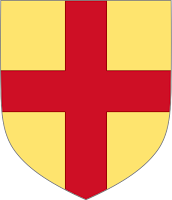Joseph, of Mollington;Mr Richardson died in 1614.
William;
ZACHARY, of whom presently;
John (Rev), Rector of Loughgall;
Joan; Margery.
The third son,
ZACHARY RICHARDSON, of Loughgall, County Armagh, had issue, with a son, William, another son,
JONATHAN RICHARDSON, of Eagralougher, Loughgall, who was father of
WILLIAM, of whom presently;Mr Richardson died in 1691, and was succeeded by his elder son,
Samuel.
WILLIAM RICHARDSON, who wedded, in 1691, Mary Calvert, and had issue,
JONATHAN, of whom hereafter;Mr Richardson died in 1716, and was succeeded by his eldest son,
William;
Isabella.
JONATHAN RICHARDSON, who espoused Elizabeth Nicholson, and had issue (with a daughter, Alice) a son,
JOHN RICHARDSON (1719-59), of Lisburn, who married Ruth Hogg, and had issue,
James, died unmarried;The younger son,
JONATHAN, of whom hereafter.
JONATHAN RICHARDSON (1756-), wedded Sarah Nicholson, and had issue,
JAMES NICHOLSON, his heir;The eldest son,
John;
Joseph;
Mary.
JAMES NICHOLSON RICHARDSON (1782-1847), of Glenmore, Lisburn, County Antrim, espoused A Grubb, and had issue,
Jonathan, his heir;The third son,
John Grubb, of Moyallon House;
JAMES NICHOLSON, of whom presently;
Thomas;
William;
Joshua;
Joseph.
JAMES NICHOLSON RICHARDSON (1815-99), of Lissue House, Lisburn, County Antrim, married, in 1841, Margaret Maria, daughter of B Haughton, of Banford, Gilford, County Down, and had issue,
JAMES THEODORE, his heir;Mr Richardson was succeeded by his son and heir,
Annie, m A Pim.
JAMES THEODORE RICHARDSON JP DL (1844-), who wedded, in 1873, Sarah Elizabeth, daughter of Edward Walker, of Springfield Mount, Leeds, and had issue,
James Herbert, b 1874;
Edward Theodore Haughton, b 1885;
Kathleen Marguerite; Mary Cecilia; Dorothy.
Renovations were undertaken during the 19th and early 20th century by Thomas Jackson.
The house is said to have been built by Robert Garrett, “who built the present house about 30 years ago, but from failure was never able to make the designed improvements".
Subsequently, however, Mr Garrett sold or mortgaged the property to a Major McCauley, who in 1830 sold his right of it to Captain Robert Crawford, who proceeded to refurbish and renovate the house and demesne.
The Ordnance Survey Memoirs of that period remarked that
"Lissue, the seat of Captain Crawford, stands about one and a half miles from Lisburn… The house is commodious, stands two storeys high and slated and a handsome fruit and vegetable garden containing about two English acres enclosed partly by a stone and lime wall and partly by a quickset fence.
The demesne, which consists of about 60 English acres, is chiefly plantations of several kinds of forest trees and the fields of an average size enclosed by quickset fences.
The house stands on a handsome eminence commanding a most delightful prospect of a wide extent of the counties of Antrim and Down, also of Hillsborough and the improved seats in its vicinity."
Between 1856-64, Lissue was acquired by James Nicholson Richardson, a son of the founder of J N Richardson, Sons, and Owden Ltd, linen manufacturers.
He and his brothers founded the firm of Richardson Brothers & Co. of Belfast, linen yarn merchants, which in 1840 opened an office in Liverpool for the import of flax, grain and other raw materials and the export of linen yarn and cloth.
They also founded the Inman Line of steamships with the Inman family, though following an altercation, Richardson left Liverpool and settled at Lissue.
John Nicholson Richardson made expansive improvements to the house about 1855, which included extending it to the rear and adding West and East gate lodges, under the direction of the architect Thomas Jackson.
The semi-circular porch, now removed, was also added at this time.
Between 1898 and 1915 a further major scheme of work was undertaken to the house: the semi-circular porch to the front facade was removed and two segmental bows added.
New cottages were also added to the estate.
In 1915 the occupier of Lissue was Joseph Tyney, probably a gentleman farmer.
By 1926 the occupier was John Campbell.
In 1927, Captain Lindsay purchased the house for £4,500 (about £269,000 in 2018) and made numerous improvements.
Accommodation comprised:cellars, dairy, laundry, coals, WC, garages, offices and a 400 gallon petrol tank.
Ground floor: three reception rooms, billiards-room, study, three cloakrooms, three WCs, sun porch, sewing-room, four pantries, scullery, larder, servants’ room.
First floor: five bathrooms, five WCs, twelve bedrooms, sewing-room, four servants’ bedrooms, WC and bath.
There were also two tennis courts and two badminton courts.
During the 2nd World War a section of the house was used by the Belfast Hospital for Sick Children, seemingly as a tuberculosis ward.
In 1946 it had been restored for use as a dwelling; by 1947, however, following Captain Lindsay’s death, it was transferred completely to the hospital.
The ground floor was used for five wards, matron’s office and drawing-room, kitchen apartments and lavatories; and the first floor was the resident nurses’ quarters.
In 1947 there were 35 beds, soon to be increased to 70.
In residence were a matron, sister, eight nurses and two resident maids, with a chauffeur/gardener occupying the gate lodge.
By 1948 all the outbuildings were also in use by the hospital, which vacated the premises in 1988.
In 1996 the house had lain empty for some time, but by 2002 it was occupied by the Livestock and Meat Marketing commission for Northern Ireland.
Lissue House was gutted by fire in 2016, and is currently (2024) for sale.
First published in September, 2018.












































